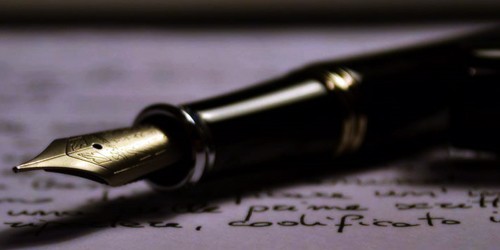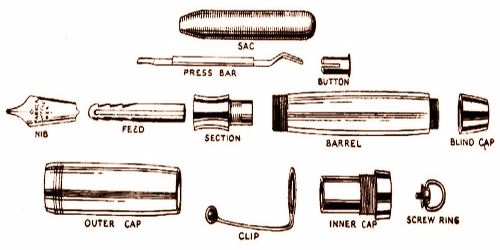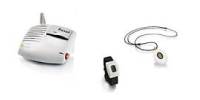A Fountain Pen is technically a nib pen which is a writing instrument equipped with a metal nib (usually solid gold) that utilizes a cartridge, converter, or other internal reservoirs in order to provide continuous and refillable ink supply. The pen draws ink from the reservoir through a feed to the nib and deposits it on paper via a combination of gravity and capillary action. Filling the reservoir with ink may be achieved manually, via the use of an eyedropper or syringe, or via an internal filling mechanism which creates suction (for example, through a piston mechanism) or a vacuum to transfer ink directly through the nib into the reservoir. Some pens employ removable reservoirs in the form of pre-filled ink cartridges.
The invention of fountain pain was few centuries before. There are arguments showing that the first construction of a fountain pen was by Leonardo da Vinci during the Renaissance period. There are evidences from his journals that contain drawings with cross-sections of a reservoir pen that works by both gravity and capillary action which substantiate the arguments.
Portability and ease of use led to fountain pens being the most popular writing instrument throughout the first half of the 20th century. In the post World War II era, cheaper ballpoint and later rollerball pens, which use a metal ball rather than pointed nib as their writing surface, became predominant. But ballpoints and rollerballs, despite their lower cost and mass production, never were able to equal fountain pens in terms of expressiveness and potential for customization.
However the world’s first patent on the fountain pen was awarded by the French Government to a Romanian inventor, Petrache Poenaru (1799-1875) on May 25, 1827. He invented a fountain pen that had a barrel made from a swan’s quill as an ink reservoir. It was described as “plume portable sans fin, qui s’alimente elle-meme avec de l’ancre” (“never-ending portable pen, which recharges itself with ink”)”.

History and Other –
According to Qadi al-Nu’man al-Tamimi (d. 974) in his Kitab al-Majalis wa ‘l-musayarat, the Fatimid caliph Al-Mu’izz li-Din Allah in Arab Egypt demanded a pen that would not stain his hands or clothes, and was provided with a pen that held ink in a reservoir, allowing it to be held upside-down without leaking. There is compelling evidence that a working fountain pen was constructed and used during the Renaissance by artist and inventor Leonardo da Vinci. Leonardo’s journals contain drawings with cross-sections of what appears to be a reservoir pen that works by both gravity and capillary action.
Samuel Pepys, English naval administrator, mentioned in his writings a metal pen “to carry ink” in 1663 while Maryland historian Hester Dorsey Richardson also wrote about fountain pens that existed in 17th century. By the early 18th century such pens were already commonly known as “fountain pens”. Hester Dorsey Richardson also found a 1734 notation made by Robert Morris the elder in the ledger of the expenses of Robert Morris the younger, who was at the time in Philadelphia, for “one fountain pen”. Perhaps the best-known reference, however, is that of Nicholas Bion (1652–1733), whose illustrated description of a “plume sans fin” was published in 1709 in his treatise published in English in 1723 as “The Construction and Principal Uses of Mathematical Instruments”. The earliest datable pen of the form described by Bion is inscribed 1702, while other examples bear French hallmarks as late as the early 19th century.
In the 19th century, standard pens were improved with mass production of cheap steel pen nibs which also influenced fountain pens. The first English patent for a fountain pen was issued in May 1809 to Frederick Fölsch, with a patent covering (among other things) an improved fountain pen feed issued to Joseph Bramah in September 1809. John Scheffer’s patent of 1819 was the first design to see commercial success, with a number of surviving examples of his “Penographic” known. Another noteworthy pioneer design was John Jacob Parker’s, patented in 1832 a self-filler with a screw-operated piston. The Romanian inventor Petrache Poenaru received a French patent on 25th May 1827, for the invention of a fountain pen with a barrel made from a large swan quill.
In America in 1848, Azel Storrs Lyman got a patent for a fountain pen with a “method of supplying ink to pens from a reservoir in the handle”. These were not the only patents for fountain pens of that time but these pens needed three inventions to become popular: iridium-tipped gold nib, hard rubber, and free-flowing ink (early fountain pens didn’t understand the role that air pressure plays in the operation of pens). First fountain pen to have all this was made in 1850s. Duncan MacKinnon and Alonzo T. Cross invented in 1870 a variant of fountain pen called stylographic pen which used a wire in a tube as a valve for ink. All these pens were filled with an eyedropper. First self-filling fountain pens were invented in the early 20th century. They were crescent-filler pens (which had a rubber sac and a crescent button which pressed it) and twist-filler pens.
Lewis Edson Waterman (1837-1901), was the inventor of the capillary feed fountain pen and also the founder of Waterman Pen Company and Ideal Pen Company. In 1883, Waterman improved a fountain pen. He noticed that fountain pens of the time didn’t have any control over the flow of ink which in turn caused the leaking of ink. He and his brother started experimenting with different tubes and in the end, they found out that if air is let into an ink reservoir of a fountain pen through capillary pipes, the ink will flow out of the reservoir under the force of gravity but slow enough not to cause leaking. Waterman remained the market leader until the early 1920s.
In 1890, W. B. Purvis patented a self-filler. Self-fillers began to arrive around the turn of the century; the most successful of these was probably the Conklin crescent-filler, followed by A. A. Waterman’s twist-filled. The tipping point, however, was the runaway success of Walter A. Sheaffer’s lever-filler, introduced in 1912, paralleled by Parker’s roughly contemporary button-filler. Meanwhile, many inventors turned their attention to the problem of leakage. Some of the earliest solutions to this problem came in the form of a “safety” pen with a retractable point that allowed the ink reservoir to be corked like a bottle. The most successful of these came from Francis C. Brown of the Caw’s Pen and Ink Co. and from Morris W. Moore of Boston.

The working principle of a fountain pen is simpler than what we can imagine. The whole process is a combination of gravity and capillary action. The fountain pen has the capability to draw ink from the reservoir through the feed to the nib and transfer it on the paper.
A typical fountain pen consists of mainly three parts:
- Nib: Nib is considered as the most iconic and recognizable part of the fountain pen. It is a metal piece which transfers the ink from the pen to the paper. The working of the nib is by drawing ink through a small slit using the capillary action. There is a small circular hole called a breather hole on the end of the ink slit which is used for the best ink flow.
- Feed: Feed is the next part after the nib and the function of this part is to supply ink from inside the Pen to the nib. Feeds usually have one main ink channel that draws ink from inside of the pen to the nib using the capillary which is exactly the same as what happens in the nib. There are hidden fins inside the feed that holds the excessive ink to help regulating the ink flow.
- Ink Reservoir: It is the most essential part in a fountain pen. It holds the ink inside the pen. It can be an ink cartridge or a special filling mechanism for sucking in and holding the bottled ink.
During the 1940s and 1950s, fountain pens retained their dominance: early ballpoint pens were expensive, were prone to leaks and had irregular ink flow, while the fountain pen continued to benefit from the combination of mass production and craftsmanship. (Bíró’s patent and other early patents on ball-point pens often used the term “ball-point fountain pen,” because at the time the ball-point pen was considered a type of fountain pen; that is, a pen that held ink in an enclosed reservoir.) This period saw the launch of innovative models such as the Parker 51, the Aurora 88, the Sheaffer Snorkel, and the Eversharp Skyline and (later) Skyliner, while the Esterbrook J series of lever-fill models with interchangeable steel nibs offered inexpensive reliability to the masses.
The fountain ink is mainly made of water, the solvent of the ink. The solute that we are using inside the fountain pen is normally a water-soluble aniline dye composed of a Nitrate group bound to a phenyl group forming a basic amine, phenylamine. Rather than these, there are some other solutes which are, surfactants to increase the flow of ink, such as biocide compounds for the prevention of fungal growth in ink and glycerine to increase the viscosity of the ink.
Fountain pens never lost their allure in Europe and Asia, and in the late 1970s a renaissance of interest began in the United States as well, leading to what many now consider a new golden age of fountain pens that rivals that of the 1920’s and 30’s. From everyday writing instruments to one of a kind works of hand-crafted art, fountain pens remain an essential writing tool for many business professionals, calligraphers, artists, and pen enthusiasts. Or just anybody who likes to write with a pen on paper.
Information Sources:
















